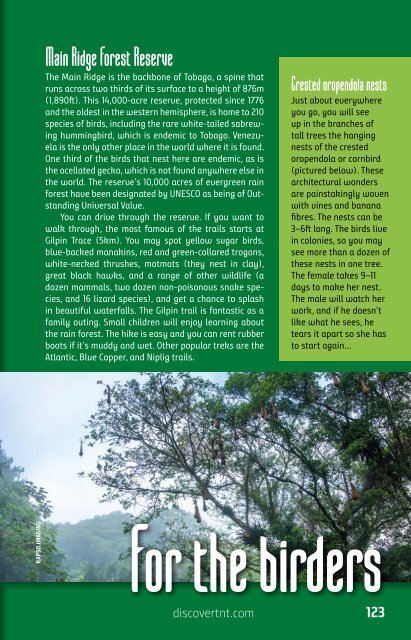Discover Trinidad & Tobago 2018 (#29)
Discover T&T has published 29 issues since 1991, and helps readers discover where to stay, dine, lime, party, and shop; and what to see (including the islands’ best sites) and experience (festivals, arts and culture, sports, and eco escapes), in both islands. There’s also a national calendar of events; info on getting here and getting around; tips for safe and sustainable travel; T&T history and society in a nutshell, maps; and more. For the third edition in the row, the magazine features a distinctive dual-cover design, with one cover for each island — a ruby topaz humming- bird photographed in the Arima Valley (photograph by Wendell Stephen Jay Reyes) and the relaxing scene of someone lounging atop a glass- bottom boat in the Nylon Pool (photograph by Tarique Eastman). Discover T&T is aimed at local and international explorers planning getaways to the islands — whether for an eco adventure, business trip, or beach holiday. For more: http://www.discovertnt.com
Discover T&T has published 29 issues since 1991, and helps readers discover where to stay, dine, lime, party, and shop; and what to see (including the islands’ best sites) and experience (festivals, arts and culture, sports, and eco escapes), in both islands. There’s also a national calendar of events; info on getting here and getting around; tips for safe and sustainable travel; T&T history and society in a nutshell, maps; and more.
For the third edition in the row, the magazine features a distinctive dual-cover design, with one cover for each island — a ruby topaz humming- bird photographed in the Arima Valley (photograph by Wendell Stephen Jay Reyes) and the relaxing scene of someone lounging atop a glass- bottom boat in the Nylon Pool (photograph by Tarique Eastman).
Discover T&T is aimed at local and international explorers planning getaways to the islands — whether for an eco adventure, business trip, or beach holiday. For more: http://www.discovertnt.com
Create successful ePaper yourself
Turn your PDF publications into a flip-book with our unique Google optimized e-Paper software.
Main Ridge Forest Reserve<br />
The Main Ridge is the backbone of <strong>Tobago</strong>, a spine that<br />
runs across two thirds of its surface to a height of 876m<br />
(1,890ft). This 14,000-acre reserve, protected since 1776<br />
and the oldest in the western hemisphere, is home to 210<br />
species of birds, including the rare white-tailed sabrewing<br />
hummingbird, which is endemic to <strong>Tobago</strong>. Venezuela<br />
is the only other place in the world where it is found.<br />
One third of the birds that nest here are endemic, as is<br />
the ocellated gecko, which is not found anywhere else in<br />
the world. The reserve’s 10,000 acres of evergreen rain<br />
forest have been designated by UNESCO as being of Outstanding<br />
Universal Value.<br />
You can drive through the reserve. If you want to<br />
walk through, the most famous of the trails starts at<br />
Gilpin Trace (5km). You may spot yellow sugar birds,<br />
blue-backed manakins, red and green-collared trogons,<br />
white-necked thrushes, motmots (they nest in clay),<br />
great black hawks, and a range of other wildlife (a<br />
dozen mammals, two dozen non-poisonous snake species,<br />
and 16 lizard species), and get a chance to splash<br />
in beautiful waterfalls. The Gilpin trail is fantastic as a<br />
family outing. Small children will enjoy learning about<br />
the rain forest. The hike is easy and you can rent rubber<br />
boots if it’s muddy and wet. Other popular treks are the<br />
Atlantic, Blue Copper, and Niplig trails.<br />
Crested oropendola nests<br />
Just about everywhere<br />
you go, you will see<br />
up in the branches of<br />
tall trees the hanging<br />
nests of the crested<br />
oropendola or cornbird<br />
(pictured below). These<br />
architectural wonders<br />
are painstakingly woven<br />
with vines and banana<br />
fibres. The nests can be<br />
3–6ft long. The birds live<br />
in colonies, so you may<br />
see more than a dozen of<br />
these nests in one tree.<br />
The female takes 9–11<br />
days to make her nest.<br />
The male will watch her<br />
work, and if he doesn’t<br />
like what he sees, he<br />
tears it apart so she has<br />
to start again...<br />
RAPSO IMAGING<br />
For the birders<br />
discovertnt.com<br />
123


















